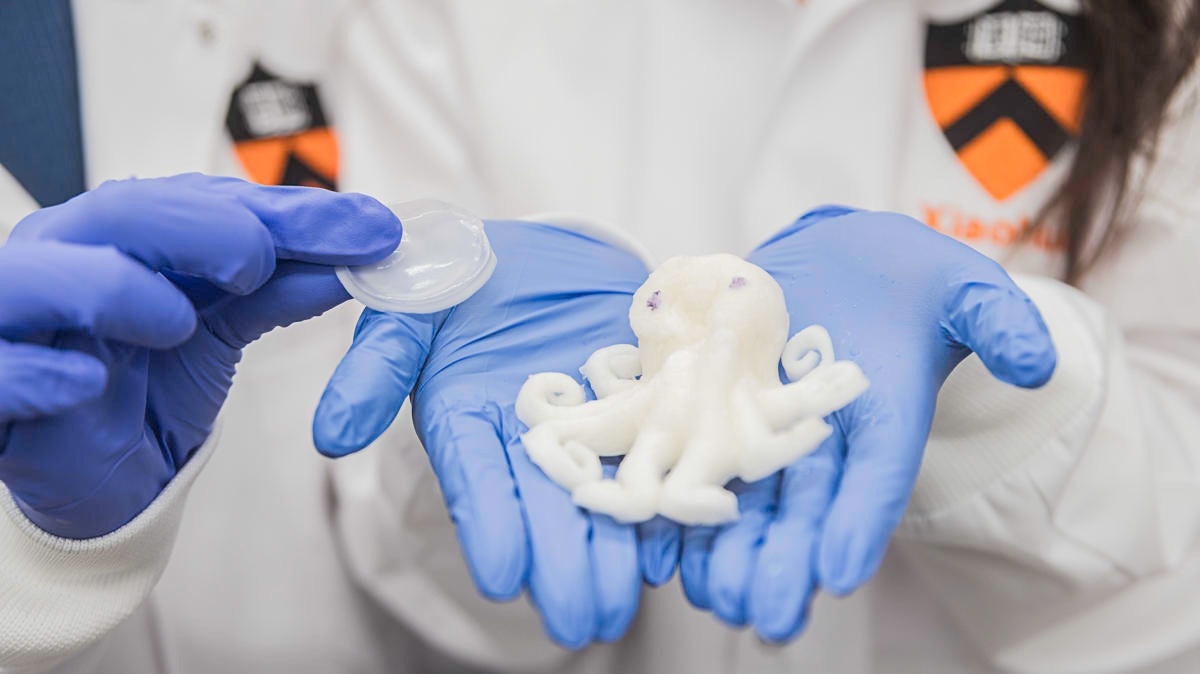Hydrogels are made of elastic networks of polymer chains that are permeated with water. They are soft, elastic, and biocompatible. As a result, the squishy materials are already widely used in contact lenses and wound care products. In addition, hydrogels have a lot of potential for use in food packaging, agriculture, and drug delivery systems.

Princeton researchers have developed have developed a new type of recyclable hydrogel that can be cut and molded into different forms. Image Credit: Dan Komoda
Regrettably, the ineffectiveness of recycling or reprocessing traditional hydrogels makes them a source of environmental degradation. Long-term usage also causes hydrogels to break down. The constraints are a result of the structure of the materials, according to the researchers. Chemical bonds are the basis for the hardness and solvent solubility of conventional hydrogels.
Chemically speaking, these bonds are cross-linked, which means that inside the hydrogel, links develop between various polymer molecules. The cross-linking that gives hydrogels their strength and flexibility is a feature of resins that are curing or vulcanizing rubber. However, this also makes it extremely difficult to disassemble them into their parts for recycling.
Lead author of the study, Xiaohui Xu is a postdoctoral researcher who has experience working with hydrogels for water purification. She was wondering if it would be possible to make a hydrogel that is more ecologically friendly. Xu and her associates approached the creation of hydrogels in a novel way.
Instead of depending on chemical bonds to join disparate polymers, the scientists chose to use phase separation—a well-known phenomenon wherein blended liquids, like water and oil, split into their constituent parts.
Hydrogels offer tremendous societal benefit, but their lack of sustainability has loomed as a significant issue. In this study, we have shown how taking advantage of phase separation can lead to new kinds of hydrogels that are durable and recyclable and still have good mechanical properties.
Xiaohui Xu, Postdoctoral Researcher, Pomeroy and Betty Perry Smith Professor, Chemical and Biological Engineering, Princeton University
In a study that was published in the September issue of the Journal of the American Chemical Society Au, the researchers detailed the procedure.
Researchers created novel hydrogel by combining polymers with different and intricate interactions with water. Polymer molecules consist of extended chains of smaller molecules, known as monomers. In certain parts of the chain, the polymers the researchers developed are attracted to water, while in other parts, they repel it. sections of the polymers absorbed the water when it was introduced, while other sections of the polymers resisted it.
The hydrogel’s structural strength was derived from this stress. In contrast to traditional hydrogels, the strength is determined by physical properties rather than chemical bonding between the individual polymers. Thus, repeatedly dehydrating and rehydrating the material is not as difficult as recycling the hydrogel back into its constituent polymers.
Furthermore, according to Xu, the procedure enables engineers to modify the polymer components to customize a hydrogel’s properties. This was used by the study team to produce a hydrogel that could be shaped and molded into any desired form. Xu took an octopus and produced it for research.
Xiaohui used phase separation as a way to control the morphology, and ultimately, the properties of these hydrogel materials. This work demonstrates an environmentally friendly approach for making tough and reusable hydrogels.
Rodney Priestly, Study Senior Author and Betty Perry Smith Professor, Chemical and Biological Engineering, Princeton University
The Princeton researchers tested the stability of the novel hydrogel in air, water, and highly acidic and alkaline environments. All things considered, the hydrogel held up and worked as it should have.
With more testing and research, the innovative material might make current and upcoming hydrogel uses more sustainable and ecologically benign, such as artificial muscles and soft robots for safe operation around humans.
Xu added, “Our general approach for recyclable hydrogels could help expand their applications in all kinds of areas. The benefits of hydrogels can now be better realized without the environmental costs.”
According to Xu, the study team is looking into whether hydrogels could eventually replace plastics in a variety of applications. If this is true, improved hydrogels could provide a recyclable answer to the plastic garbage that is threatening the oceans.
Journal Reference
Xu, X., et. al. (2023) Tough and Recyclable Phase-Separated Supramolecular Gels via a Dehydration–Hydration Cycle. Journal of the American Chemical Society Au. doi:10.1021/jacsau.3c00326